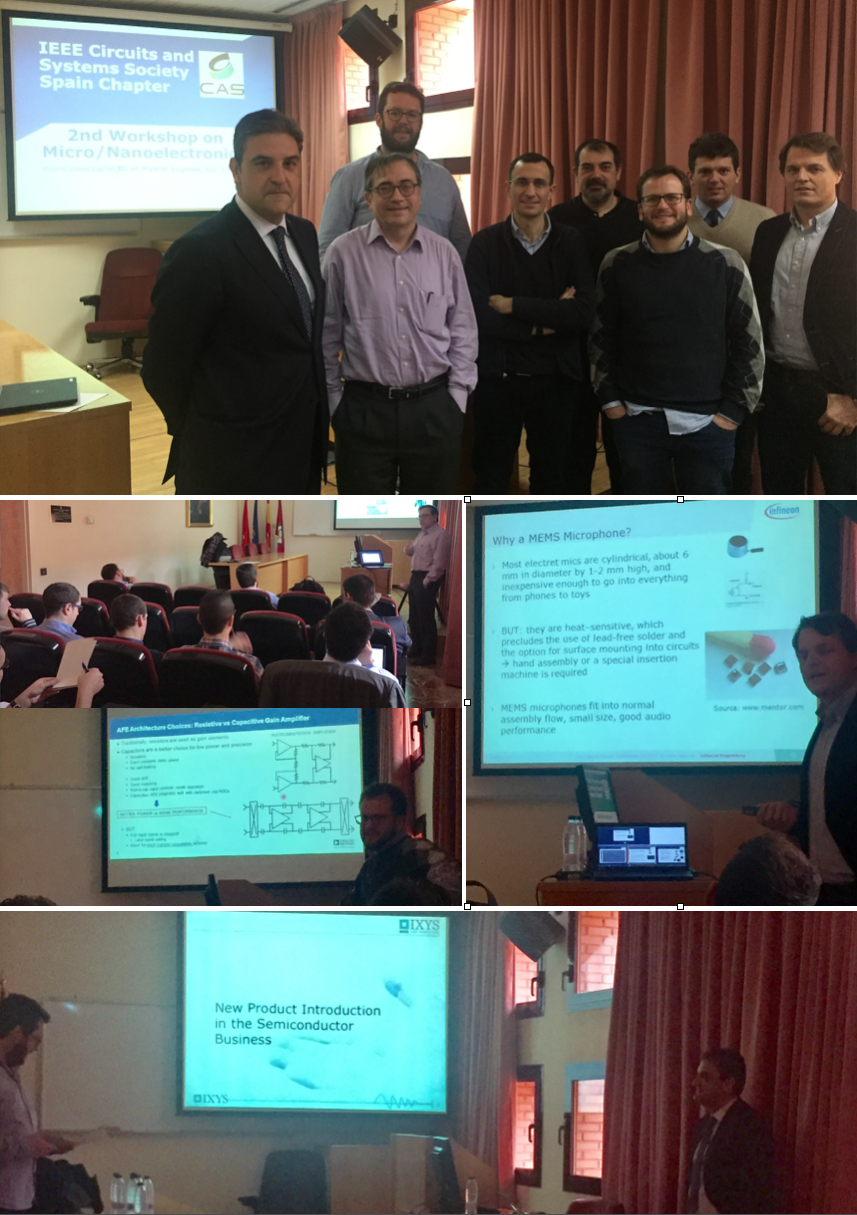2nd Spain IEEE-CASS Workshop on Micro/Nanoelectronic Circuits and Systems
The Spain Chapter of the IEEE Circuits and Systems organized the 2nd Workshop on Micro/Nanoelectronic Circuits and Systems, which was locally organized by the "Universidad Carlos III de Madrid," in Madrid, Spain on January 27, 2017. In this edition of the workshop, some distinguished speakers involved in different semiconductors companies, mostly coming from their design centers in Spain, were invited to participate. They gave an overview of some of their recent research activities and products, putting emphasis on those practical considerations to design successful integrated circuits and systems in real applications while optimizing their design-to-market deployment.
TECHNICAL PROGRAM
10:00 – 11:30: Javier Calpe Maravilla, Gerard Mora Puchalt
Analog Devices Inc.
A brief discussion on the semiconductor industry
Abstract: The semiconductor industry has been growing at a fabulous pace and been the paradigm of exponential growth and innovation. Some challenges are raising some questions. Is microelectronics already a mature industry? This presentation will synthesize the story and the current state in this highly motivating business.
Design Methodology and Techniques for a Precision Low Power Signal Chain
Abstract: We will present a methodology when designing a precision low-power signal chain. The methodology will be motivated using the case study of signal chain using PGA and DSM. We will discuss the trade-offs one has to make when deciding on power split in the chain, architectural choices (resistive Vs. capacitive PGA, or SAR Vs. DSM), technology node etc. At the same time we will present variety of modes that could make the signal chain system smart. Finally we will talk on reducing leakage and matching, when dealing with low-current circuits.
Chain Ultra-low power photoplethysmograhy SpO2 measuring techniques
Abstract: Photoplethysmograph(y (PPG) is widely used to obtain vital signs such as the peripheral capillary oxygen saturation (SpO2) or the heart rate (HR) non-invasively in real time. PPG requires a great amount of power to obtain reliable data, and its use is limited to mains powered devices. For this reason it is relevant to find methods and algorithms that reduce its current consumption. We will discuss some ideas and techniques to reduce power consumption in this application.
11:30 – 13:00: Javier Hernández de Miguel
IXYS San Sebastian S.A.
New Product Introduction in the semiconductor business
Abstract: The shape and dynamics of the semiconductor market have changed dramatically, driven by the exploding demand for smart, innovative, new connected devices. Now, semiconductor manufacturers must cater to the demands of these consumer device makers, providing new products faster, with more features and functions, while managing increasing complexity and cost. These factors are challenging existing operating models and call for new ways of doing business. To meet these challenges and tap into new opportunities that come with the surging demand for new devices, semiconductor vendors need to drive improvements across their business operations and supply chains.
14:00 – 15:30: Richard Gaggl, Cesare Buffa
Infineon
Introduction to Silicon Microphone Systems
Abstract: Silicon microphones have been established as a billion pieces per year market in the field of acoustic sensor technology. The main driving products for the large demand are mobile phones, tablet PCs, hearing aids, gaming consoles and camcorders. The consumer market is showing a clear need for increased performance to improve quality for voice-recognition and music recording. This requires a development of innovative low-power architectures for achieving a large signal-to-noise ratio along with processing of large sound pressure levels. This presentation gives an introduction into the architecture and design of a silicon microphone for consumer applications. An example of a readout circuit for processing of high sound pressure levels will be discussed.
15:30 – 17:00: Alberto Rodríguez
KDPOF
Transmitting 1Gbps over POF: a focus on the analog and mixed signal performance
Abstract: KDPOF has developed a high spectral efficiency communication technology that exploits the available capacity of large core Plastic Optical Fiber (POF). This technology, which is already a standard in the IEEE 802.3bv group, is a disruptive way of communicating by optical means, as it uses technologies closer to copper or wireless transmissions. Because of this, the complexity of both digital and analog performance of the transceivers increase compared to traditional optical transceivers. This talk analyses the trade-offs of the analog and mixed signal blocks involved in these applications

